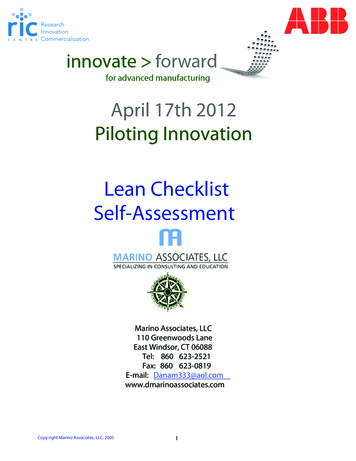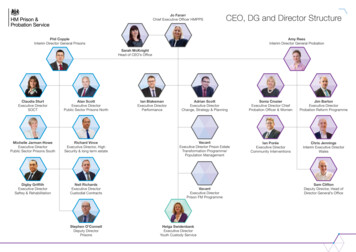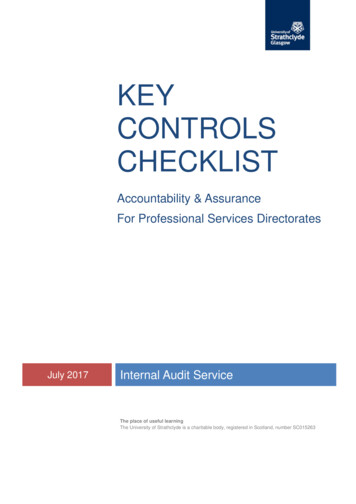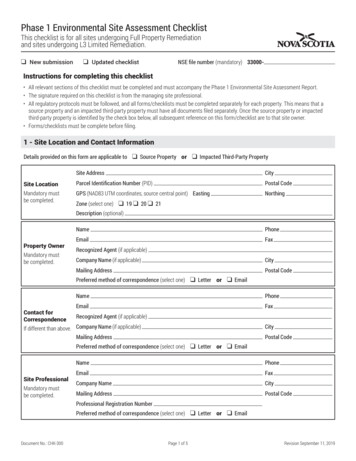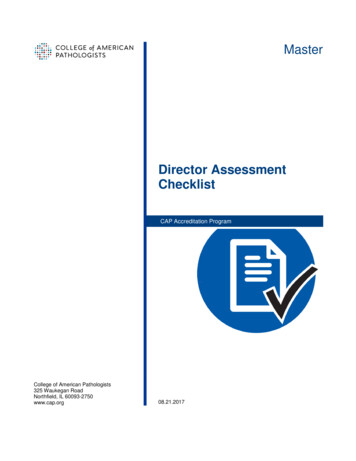
Transcription
MasterDirector AssessmentChecklistCAP Accreditation ProgramCollege of American Pathologists325 Waukegan RoadNorthfield, IL 60093-2750www.cap.org08.21.2017
2 of 23Director Assessment Checklist08.21.2017Disclaimer and Copyright NoticeOn-site inspections are performed with the edition of the Checklists mailed to a facility at the completion ofthe application or reapplication process, not necessarily those currently posted on the website. Thechecklists undergo regular revision and a new edition may be published after the inspection materials aresent.For questions about the use of the Checklists or Checklist interpretation, email accred@cap.org or call 800323-4040 or 847-832-7000 (international customers, use country code 001).The Checklists used for inspection by the College of American Pathologists' Accreditation Programs havebeen created by the CAP and are copyrighted works of the CAP. The CAP has authorized copying and useof the checklists by CAP inspectors in conducting laboratory inspections for the Commission on LaboratoryAccreditation and by laboratories that are preparing for such inspections. Except as permitted by section107 of the Copyright Act, 17 U.S.C. sec. 107, any other use of the Checklists constitutes infringement of theCAP's copyrights in the Checklists. The CAP will take appropriate legal action to protect these copyrights.All Checklists are 2017. College of American Pathologists. All rights reserved.
3 of 23Director Assessment Checklist08.21.2017Director AssessmentChecklistTABLE OF CONTENTSSUMMARY OF CHANGES . 4UNDERSTANDING THE CAP ACCREDITATION CHECKLIST COMPONENTS . 6INTRODUCTION . 6INSTRUCTIONS . 6DEFINITION OF TERMS . 9LABORATORY DIRECTOR ASSESSMENT . 13QUALIFICATIONS AND GENERAL REQUIREMENTS . 14LABORATORY DIRECTOR RESPONSIBILITY AND OVERSIGHT. 17
4 of 23Director Assessment Checklist08.21.2017ON-LINE CHECKLIST AVAILABILITYParticipants of the CAP accreditation programs may download the checklists from the CAP website(www.cap.org) by logging into e-LAB Solutions. They are available in different checklist types and formattingoptions, including: Master — contains ALL of the requirements and instructions available in PDF, Word/XML or Excel formatsCustom — customized based on the laboratory's activity (test) menu; available in PDF, Word/XML or ExcelformatsChanges Only — contains only those requirements with significant changes since the previous checklistedition in a track changes format to show the differences; in PDF version only. Requirements that havebeen moved or merged appear in a table at the end of the file.SUMMARY OF CHECKLIST EDITION CHANGESDirector Assessment Checklist08/21/2017 EditionThe information below includes a listing of checklist requirements with significant changes in the current editionand previous edition of this checklist. The list is separated into three categories:1. New2. Revised: Modifications that may require a change in policy, procedure, or process for continuedcompliance; or A change to the Phase3. Deleted/Moved/Merged: Deleted Moved — Relocation of a requirement into a different checklist (requirements that have beenresequenced within the same checklist are not listed) Merged — The combining of similar requirementsNOTE: The listing of requirements below is from the Master version of the checklist. The customized checklistversion created for on-site inspections and self-evaluations may not list all of these requirements.NEW Checklist RequirementsRequirementTLC.10445Effective Date08/21/2017REVISED Checklist TLC.11400TLC.11425Effective 2017DELETED/MOVED/MERGED Checklist Requirements
5 of 23Director Assessment ChecklistRequirementTLC.11600Effective Date08/20/201708.21.2017
6 of 23Director Assessment Checklist08.21.2017UNDERSTANDING THE CAP ACCREDITATIONCHECKLIST COMPONENTSAll checklist requirements contain a requirement number, subject header, phase, and a declarative statement.Some requirements also contain a NOTE and/or Evidence of Compliance.The NOTE portion of a checklist requirement provides additional detail to assist in interpreting the requirement.Evidence of Compliance (EOC) is intended to: Suggest specific examples of acceptable records; some elements are required Assist in inspection preparation and for managing ongoing compliance Drive consistent understanding of requirementsIf a policy or procedure is referenced within a requirement, it is only repeated in the Evidence of Compliance ifsuch statement adds clarity. All policies or procedures covered in the CAP checklists must be a writtendocument. A separate policy or procedure may not be needed for items in EOC if it is already addressed by anoverarching policy.The Master version of the checklist also contains references and the inspector R.O.A.D. instructions (Read,Observe, Ask, Discover), which can provide valuable insight for the basis of requirements and on howcompliance will be assessed.INTRODUCTIONThe Director Assessment Checklist was formerly known as the Team Leader Assessment of Director & QualityChecklist. The checklist name was changed to the Director Assessment Checklist to emphasize the role of thedirector and focus the assessment on the fulfillment of laboratory director responsibilities. The checklist willcontinue to be used primarily by the team leader to perform a peer assessment of the laboratory director's rolein ensuring laboratory quality. The TLC prefix continues to be used as an identifier for each requirement (e.g.TLC.10100).INSTRUCTIONSThis checklist will help you evaluate the qualifications of the laboratory director and the effectiveness ofthe director in implementing the Standards of the Laboratory Accreditation Program, including thelaboratory's quality management plan. Record any major or systemic deficiencies detected during theon-site inspection that reflect lack of director oversight in areas such as QC, QM, proficiency testing,employee qualifications and records, competence and training, and the maintenance of a safe workenvironment. Record any major or systemic issues identified, and elaborate on these findings in theInspector's Summary Report, Part A (ISR-A).This checklist must be completed by the team leader or a team member who is qualified and trained tobe a team leader. It is important to cite IN THIS CHECKLIST, any systemic issues identified, and toelaborate on these findings in the Inspector's Summary Report, Part A (ISR-A).The following activities provide the information needed to complete the requirements in this checklist:1. Interview the laboratory director.2. Interview laboratory supervisory personnel and other laboratory personnel as appropriate.
7 of 23Director Assessment Checklist08.21.20173. Observe the operation of the laboratory during your time on-site.4. Review the laboratory organizational chart, quality management plan and records, committeeminutes, and other relevant documents for appropriate director involvement.5. Interview the hospital administrator. If the laboratory is an independent organization,interview an executive from the organization.6. Interview the chief of the medical staff (for laboratories associated with a medical staff).7. Discussion with members of the inspection team to assess the extent of deficiencies.Deficiencies that directly affect patient safety, or are pervasive in the laboratory, may warranta deficiency in the Director Oversight Responsibilities section of this checklist.Interviews with the laboratory director, hospital or organization administrator, and representative of themedical staff are essential parts of the inspection. If for any reason one of these interviews was notperformed, discuss the circumstances in the Inspector's Summation Report.Meeting with the Laboratory DirectorPurpose: To help determine if the laboratory director has sufficient responsibility and authority for operation ofthe laboratory. Allow a minimum of 15-20 minutes for the meeting.The interview is an opportunity to: Evaluate the director's activities as listed in the Standards for Laboratory AccreditationReview any problems that the inspection experience might serve to resolve (e.g. space problems, staffingshortages)Determine whether the laboratory director also functions as a technical supervisor, clinical consultant,general supervisor, or as a testing personnel. If so, review the Personnel section of the Laboratory GeneralChecklist for qualifications and responsibilities.Meeting with the Organization/Hospital Administrator/Chief Executive Officer (CEO)For hospital-based laboratories, the inspector should meet with the hospital administrator/CEO. Allow at least15-20 minutes for the meeting. Avoid scheduling the meeting early in the inspection to have a sense of thelaboratory's operations first. For independent laboratories, meet with an executive from the laboratoryorganization.Purpose: To extend the College's appreciation for participating in the accreditation program, to record anevaluation of the laboratory from the administration's viewpoint, and help assess the director's involvement inthe administration of the laboratory.Points to communicate during the interview are: The goals of the CAP Laboratory Accreditation Program: education and laboratory improvement;establishing best practices in laboratory medicine, based on input from national expertsInspection method: two-year accreditation cycle; use of active laboratorians as inspectors; educationalvalue to inspector and inspected laboratoryThe role of proficiency testing in the programLaboratory director: the laboratory director is responsible for the overall operation of the laboratory, underthe requirements of the CAP Laboratory Accreditation ProgramThe interview is an opportunity to: Ascertain the administration's perception of the laboratory serviceDiscuss administration's view of the laboratory director's role in ensuring high quality laboratory services tofulfill the needs of the institution's patients and cliniciansDetermine if the institution gives the director the authority to fulfill the director's responsibilities under CAP
8 of 23Director Assessment Checklist 08.21.2017Address the effectiveness of the working relationship among the laboratory, its director and administrationIdentify any areas of conflictDiscuss all laboratories being inspected. Do not discuss any financial and/or contractual arrangements.When speaking with the hospital administrator, ask if the laboratory service level is appropriate to the needs ofthe institution. Ask how the pathologists participate in hospital-wide committees, how effective they are inworking with the medical and administrative staffs, and whether they meet the expectations of theadministration.Record key findings from this interview in Part A of the Inspector's Summation Report.Meeting with a Representative of the Medical StaffFor laboratories associated with organized medical staffs, it is important for the team leader to interview thechief of the medical staff (or other knowledgeable medical staff representative, such as the chief medical officer,or a physician who uses the laboratory's services frequently).Allow for a 15-20 minute discussion, and come prepared with a general understanding of the laboratory'soperations beforehand.Purpose: To determine whether the director and the laboratory staff have established an effective workingrelationship with the medical staff and are effectively supporting patient care.The interview is an opportunity to: Evaluate how effectively the scope, quality, and timeliness of laboratory services meet the patient careneeds of the hospitalAssess the contribution of the pathologist and laboratory staff to teaching conferences and meetingsDetermine the cooperation of medical staff and pathologist in problem resolutionJudge the medical community's perception of the effectiveness of the laboratory director and otherpathologists, and determine if the laboratory director has sufficient authority to fulfill the needs of the medicalstaff and patientsWhen meeting with the chief or other active member of the medical staff, ask questions about the scope, qualityand timeliness of laboratory services. The team leader should ask the medical staff representative for input onpathologist participation in medical staff committees, participation in institutional quality management(performance improvement) and patient safety activities, and participation in teaching conferences. Include alllaboratories being inspected, including special function and satellite laboratories.The inspector may record information from this interview in Part A of the Inspector's Summation Report.Pre-Summation ConferencePrior to the summation conference, allow 30-60 minutes to meet privately as a group with the inspection teammembers to discuss and record inspection findings. The goal of the meeting is to ensure that both verbal andwritten inspection reports are complete and consistent. During the meeting: Resolve team members' questions Ensure consistency in recording similar findings (e.g. deficiency versus recommendation) Identify serious deficiencies that may jeopardize patient care and systemic problems where inspectors citedthe same or related deficiencies in multiple laboratory sections Review the Part A Questions in the Inspector's Summation Report If serious deficiencies or systemic issues are identified or any question from Part A is answered"NO," cite the appropriate checklist requirements relating to the issue and the TLC Checklistrequirement for the laboratory director responsibility.
9 of 23Director Assessment ChecklistCommon examples include:Issue ObservedLack of laboratory director involvementQM plan not properly implemented08.21.2017Related TLC RequirementTLC.10430TLC.10440Lack of thoroughness of the self-inspection and/or inadequate oruntimely correction of deficiencies noted during the self-inspectionprocessInconsistent quality control/lack of corrective actionImproper handling of proficiency testing materials/lack of follow-up forunacceptable resultsLack of validation/verification records for new tests or instrumentsInsufficient numbers of personnel or incomplete records for personnelqualifications and/or trainingUnsafe laboratory practices compromise the safety of personnelTLC.10445Incomplete records for delegation of duties or duties not effectivelycarried out by designee(s) (e.g. competency assessments notperformed as required by designee) or delegation of functions toindividuals who lack the necessary TLC.11300TLC.11400Summation ConferenceCitations in this checklist are optional for discussion at the summation conference to which laboratory staff,hospital administration, and others may be invited. The team leader may instead choose to discuss them withthe laboratory director in a private summation meeting.DEFINITION OF TERMSAddendum - Information appended to a final report with no changes to the original test result(s); original reportis intact and unchanged, the addendum is added as an attachment or supplement to the original report.Alternative assessment - A system for determining the reliability of laboratory examinations for which nocommercial proficiency testing products are available, are not appropriate for the method or patient populationserved by the laboratory, or participation is not required by the accrediting organization.Amended/amendment - Any change in a previously issued anatomic pathology or cytopathology reportintended to correct an inaccuracy, including changes in the diagnosis, narrative text, clinical history, pre- andpost-operative diagnoses, patient identification, or other content.Analytical validation - The process used to confirm with objective evidence that a laboratory-developed ormodified FDA-cleared/approved test method or instrument system delivers reliable results for the intendedapplication.Analytical verification - The process by which a laboratory determines that an unmodified FDAcleared/approved test performs according to the specifications set forth by the manufacturer when used asdirected.Annual - Every 12 calendar monthsBiennial - Every 24 calendar months
10 of 23Director Assessment Checklist08.21.2017Authority - The power to give orders or make decisions: the power or right to direct someone or control aprocessCalibrator, historical - The set of archived results of a single-point calibrator that demonstrates stability of theassay over timeCheck - Examination to determine the accuracy, quality or presence of any attribute of a test systemClinical validation - The determination of the ability of a test to diagnose or predict risk of a particular healthcondition or predisposition, measured by sensitivity, specificity, and predictive valuesCommutable - The property of a reference material that yields the same numeric result as would a patient'sspecimen containing the same quantity of analyte in the analytic method under discussion (i.e. matrix effects areabsent).Confirmation - Substantiation of the correctness of a value or processCorrected/correction - A change in a previously issued clinical pathology test report intended to correct aninaccuracy, including changes in test results, patient identification, reference intervals, interpretation, or othercontent.Corrective Action - Action taken to eliminate the cause of a detected nonconformity or other undesirablesituationCorrelation - Establishment of agreement between two or more measured valuesCredentialing - The process of obtaining, verifying, and assessing the qualifications of a practitioner to providecare in a health care organizationDevice - Any reagent, reagent product, kit, instrument, apparatus, equipment or related product, whether usedalone or in combination, intended by the manufacturer to be distributed for use in vitro for the examination ofhuman specimensDigital image analysis - The computer-assisted detection or quantification of specific features in an imagefollowing enhancement and processing of that image, including analysis of immunohistochemistry samples,DNA analysis, morphometric analysis, and in situ hybridizationEquipment - Single apparatus or set of devices or apparatuses needed to perform a specific taskExamination - In the context of checklist requirements, examination refers to the process of inspection oftissues and samples prior to analysis. An examination is not an analytical test.FDA - 1) For laboratories subject to US regulations, FDA refers to the US Food and Drug Administration, whichis the regulatory body under Health and Human Services (HHS) with authority to regulate in vitro diagnosticproducts such as kits, reagents, instruments, and test systems; 2) For laboratories not subject to US regulations,FDA refers to the national, regional, or local authority having jurisdiction over in vitro diagnostic test systems.Function Check - Confirmation that an instrument or item of equipment operates according to manufacturer'sspecifications prior to initial use, at
Aug 21, 2017 · director and focus the assessment on the fulfillment of laboratory director responsibilities. The checklist will continue to be used primarily by the team leader to perform a peer asse


